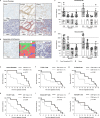Tumor immune dynamics and long-term clinical outcome of stage IIIA NSCLC patients treated with neoadjuvant chemoimmunotherapy
- PMID: 41027867
- PMCID: PMC12484868
- DOI: 10.1038/s41467-025-63696-5
Tumor immune dynamics and long-term clinical outcome of stage IIIA NSCLC patients treated with neoadjuvant chemoimmunotherapy
Abstract
Neoadjuvant chemoimmunotherapy offers promise to improve outcomes for patients with resectable non-small cell lung cancer (NSCLC). Yet not all patients derive treatment benefits, and reliable biomarkers of response are still lacking. We here assess the long-term clinical outcome of neoadjuvant chemotherapy and perioperative anti-PD-L1 inhibition in resectable stage IIIA NSCLC in the SAKK 16/14 trial and provide a comprehensive characterization of anti-tumor immune responses for biomarker-based treatment personalization. We report secondary outcomes of median event-free survival (EFS) of 4.0 years and median overall survival not being reached after a median follow-up of 5.4 years. Computer-aided spatial image analysis emphasizes the importance of CD8+ T cell positioning in tumors, and larger tertiary lymphoid structures in pre-treatment biopsies correlate with improved EFS. Genomic techniques reveal the association of intratumoral TCR diversity with response. Finally, circulating proliferating CD39+ PD-1+ CD8+ T cells and elevated levels of CCL15 post-treatment are seen in patients with sustained therapeutic benefit. NCT02572843.
© 2025. The Author(s).
Conflict of interest statement
Competing interests: D.S., B.S., MaMa, P.H., O.R.O., S.H., G.T., A.B., C.W., M.B., M.G. and I.A. do not report competing interests. M.T.: Numab Therapeutics (employment and equity or stocks). K.L.: LNS Laboratoire national de santé (employment). P.J.: Thermo Fisher Scientific (employment). S.S.P.: Novartis (honoraria), Diaceutics Ireland Limited, Merck (Schweiz) AG, AstraZeneca AG (consulting or advisory role). M.N.: AstraZeneca PLC (employment and equity or stocks). M.P.: Janssen-Cilag (honoraria), AbbVie, AstraZeneca, Boehringer Ingelheim, Bristol Myers Squibb, Eisai Europe, MSD Oncology, Novartis, Pfizer/EMD Serono, Roche, Takeda, Merck Serono (consulting or advisory role), Takeda (expert testimony), Vifor Pharma, Bristol Myers Squibb, Boehringer Ingelheim, AstraZeneca (travel, accommodation, expenses). M.F.: BMS, AstraZeneca, MSD, Takeda, Roche, Lilly (consulting or advisory role), Pfizer (speakers’ bureau), BMS, AstraZeneca (research funding) LAM: Takeda, Roche, AstraZeneca, Bristol Myers Squibb, Merck Sharp & Dohme, Pfizer (consulting or advisory role), Takeda, Bristol Myers Squibb, Merck, Roche, AstraZeneca (travel, accommodation, expenses). C.B.: AstraZeneca, Pfizer, Roche, Takeda, Janssen-Cilag, Boehringer Ingelheim (consulting or advisory role), AstraZeneca, Takeda (travel, accommodation, expenses). S.P.: Roche, Bristol Myers Squibb, Novartis, Pfizer, MSD, AstraZeneca, Takeda, Illumina, Medscape (honoraria), Roche/Genentech, Novartis, Bristol Myers Squibb, Pfizer, MSD, Amgen, AstraZeneca, Janssen, Regeneron, Merck Serono, Boehringer Ingelheim, Takeda, Lilly, AbbVie, Bayer, Biocartis, Debiopharm Group, Illumina, PharmaMar, Sanofi, Seattle Genetics, Blueprint Medicines, Daiichi Sankyo, Incyte, Bioinvent, Clovis Oncology, Vaccibody, Phosplatin Therapeutics (consulting or advisory role), Roche, BMS, MSD, Amgen, Lilly, AstraZeneca, Pfizer, Illumina, Merck Serono, Novartis, Biodesix, Boehringer Ingelheim, Iovance Biotherapeutics, Phosplatin Therapeutics (research funding), Roche, Bristol Myers Squibb, MSD, Sanofi, Incyte (travel, accommodation, expenses). MiMa: Roche, AstraZeneca, Takeda, BMS, MSD Oncology (consulting or advisory role), Pfizer, Roche, Takeda (travel, accommodation, expenses). A.F.O.: Tolremo (consulting or advisory role), argenx (research funding) W.D.J.: Roche, Takeda, MSD, Novartis (consulting or advisory role). N.M.: MaxVAX SA (stock or equity, research funding). P.F.: Pfizer, Takeda, Roche, Boehringer Ingelheim, AstraZeneca, Novartis, Bayer (consulting or advisory role). P.B.: MSD, Bayer (consulting or advisory role), Janssen (travel, accommodation, expenses). S.R.: Bristol Myers Squibb, AstraZeneca, Boehringer Ingelheim, Eisai, Roche, Novartis, Merck Serono, MSD Oncology, Pfizer, Takeda, AbbVie (consulting or advisory role), Boehringer Ingelheim, AstraZeneca, Bristol Myers Squibb, Eisai, Merck Serono, AbbVie (research funding), Roche, AstraZeneca, Bristol Myers Squibb (expert testimony), Roche Pharma AG, Lilly, Bristol Myers Squibb, AstraZeneca, Merck Sharp & Dohme, Amgen (travel, accommodation, expenses). V.H.K.: Sharing Progress in Cancer Care, Indica Labs (invited speaker), Takeda (consulting or advisory role), Roche, IAG (research funding), patent applications on the assessment of cancer immunotherapy biomarkers by digital pathology and for the prediction of cancer recurrence risk and prediction of treatment efficacy using deep learning, unrelated to the current study. A.Z.: Roche, NBE Therapeutics, Engimmune (consulting or advisory role), Roche, Bright Peak Therapeutics, T3 Pharma (research funding).
Figures






References
-
- Siegel, R. L., Miller, K. D. & Jemal, A. Cancer statistics, 2020. CA Cancer J. Clin.70, 7–30 (2020). - PubMed
-
- Goldstraw, P. et al. The IASLC Lung Cancer Staging Project: proposals for revision of the TNM stage groupings in the forthcoming (eighth) edition of the TNM classification for lung cancer. J. Thorac. Oncol.11, 39–51 (2016). - PubMed
-
- Pless, M. et al. Induction chemoradiation in stage IIIA/N2 non-small-cell lung cancer: a phase 3 randomised trial. Lancet386, 1049–1056 (2015). - PubMed
-
- Betticher, D. C. et al. Mediastinal lymph node clearance after docetaxel-cisplatin neoadjuvant chemotherapy is prognostic of survival in patients with stage IIIA pN2 non-small-cell lung cancer: a multicenter phase II trial. J. Clin. Oncol.21, 1752–1759 (2003). - PubMed
MeSH terms
Substances
Associated data
LinkOut - more resources
Full Text Sources
Medical
Research Materials

